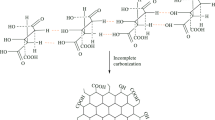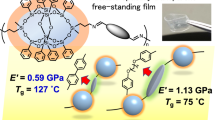Abstract
We prepared four types of water-soluble polymers with anchoring group(s) at one or both terminals: poly(ethylene glycol) (PEG) with one or two anchoring groups and polyrotaxane with one or two anchoring groups. Each polymer was immobilized to successfully form a loop or graft structure on a gold substrate covered with a self-assembled monolayer (SAM) of a tri(ethylene glycol)-dodecanethiol conjugate. Controlled immobilization of the polymers onto a gold substrate was examined by an original two-step protocol and was confirmed by quartz crystal microbalance (QCM) measurement. We investigated the effects of the immobilization modes (loop and graft) of the polymers on the surface properties of biomaterials. Surface softness or rigidity of the hydrated polymers on a SAM was analyzed by QCM with dissipation monitoring measurements, by which we found smaller ratios of energy dissipation to frequency (ΔD/Δf) for a loop structure than for a graft structure in an aqueous environment. With regard to surface wettability, substrates with PEG or polyrotaxane were similar in terms of static and dynamic contact angles and were also not influenced by the immobilization modes. We demonstrate that less fibrinogen was adsorbed on the polyrotaxane loop, making it a good platform for the design of biomaterials surfaces.
Similar content being viewed by others
Log in or create a free account to read this content
Gain free access to this article, as well as selected content from this journal and more on nature.com
or
References
Gorbet, M. B. & Sefton, M. V. Biomaterial-associated thrombosis: roles of coagulation factors, complement, platelets and leukocytes. Biomaterials 25, 5681–5703 (2004).
Shoichet, M. S. Polymer scaffolds for biomaterials applications. Macromolecules 43, 581–591 (2010).
Chen, H. C., Yuan, L., Song, W., Wu, Z. & Li, D. Biocompatible polymer materials: role of protein surface interactions. Prog. Polym. Sci. 33, 1059–1087 (2008).
Jeon, S. I., Lee, J. H., Andrade, J. D. & De Gennes, P. G. Protein-surface interactions in the presence of polyethylene oxide: I. Simplified theory. J. Colloid Interf. Sci. 142, 149–158 (1991).
Jeon, S. I. & Andrade, J. D. Protein-surface interactions in the presence of polyethylene oxide: II. Effect of protein size. J. Colloid Interf. Sci. 142, 159–166 (1991).
Currie, E. P. K., Norde, W. & Cohen Stuart, M. A. Tethered polymer chains: surface chemistry and their impact on colloidal and surface properties. Adv. Colloid Interf. Sci. 100–102, 205–265 (2003).
Unsworth, L. D., Sheardown, H. & Brash, J. L. Protein resistance of surfaces prepared by sorption of end-thiolated poly(ethylene glycol) to gold: effect of surface chain density. Langmuir 21, 1036–1041 (2005).
Zheng, J., Li, L., Tsao, H.- K., Sheng, Y.- J., Chen, S. & Jiang, S. Strong repulsive forces between protein and oligo(ethylene glycol) self-assembled monolayers: a molecular simulation study. Biophys. J. 89, 158–166 (2005).
Ishihara, K., Nomura, H., Mihara, T., Kurita, K., Iwasaki, Y. & Nakabayashi, N. Why do phospholipid polymers reduce protein adsorption? J. Biomed. Mater. Res. 39, 323–330 (1998).
Yamasaki, A., Imamura, Y., Kurita, K., Iwasaki, Y., Nakabayashi, N. & Ishihara, K. Surface mobility of polymers having phosphorylcholine groups connected with various bridging units and their protein adsorption-resistance properties. Colloids Surf. B 28, 53–62 (2003).
Kitano, H., Imai, M., Mori, T., Gemmei-Ide, M., Yokoyama, Y. & Ishihara, K. Structure of water in the vicinity of phospholipid analogue copolymers as studied by vibrational spectroscopy. Langmuir 19, 10260–10266 (2003).
Feng, W., Zhu, S., Ishihara, K. & Brash, J. L. Adsorption of fibrinogen and lysozyme on silicon grafted with poly(2-methacryloyloxyethyl phosphorylcholine) via surface-initiated atom transfer radical polymerization. Langmuir 21, 5980–5987 (2005).
He, Y., Hower, J., Chen, S., Bernards, M. T., Chang, Y. & Jiang, S. Molecular simulation studies of protein interactions with zwitterionic phosphorylcholine self-assembled monolayers in the presence of water. Langmuir 24, 10358–10364 (2008).
Prime, K. L. & Whitesides, G. M. Adsorption of proteins onto surfaces containing end-attached oligo(ethylene oxide): a model system using self-assembled monolayers. J. Am. Chem. Soc. 115, 10714–10721 (1993).
Sigal, G. B., Mrksich, M. & Whitesides, G. M. Effect of surface wetability on the adsorption of proteins and detergents. J. Am. Chem. Soc. 120, 3464–3473 (1998).
Benesch, J., Svedhem, S., Svensson, S. C. T., Valiokas, R., Liedberg, B. & Tengvall, P. Protein adsorption to oligo(ethyelene glycol) self-assembled monolayers: experiments with fibrinogen, heparinized plasma, and serum. J. Biomater. Sci. Polym. Edn. 12, 581–597 (2001).
Lu, H. B., Campbell, C. T. & Castner, D. G. Attachment of functional poly(ethylene glycol) films to gold surfaces. Langmuir 16, 1711–1718 (2000).
Yang, D. H., Katoono, R., Yamaguchi, J., Muira, Y. & Yui, N. Immobilization of polyrotaxane on a solid substrate as the design of dynamic surface. Polym. J. 41, 952–953 (2009).
Kim, Y.- H. & Gorman, C. B. Standing up versus looping over: controlling the geometry of self-assembled monolayers of α,ω-diynes on gold. Langmuir 27, 6069–6075 (2011).
Patton, D., Knoll, W. & Advincula, R. C. Polymer loops vs brushes on surfaces: adsorption, kinetics, and viscoelastic behavior of α,ω-thiol telechelics on gold. Macromol. Chem. Phys. 212, 485–497 (2011).
Ulman, A. Formation and structure of self-assembled monolayers. Chem. Rev. 96, 1533–1554 (1996).
Wang, W., Efrima, S. & Regev, O. Directing oleate stabilized nanosized silver colloids into organic phases. Langmuir 14, 602–610 (1998).
Buttry, D. A. & Ward, M. D. Measurement of interfacial processes at electrode surfaces with the electrochemical quartz crystal microbalance. Chem. Rev. 92, 1355–1379 (1992).
Rodahl, M., Höök, F., Krozer, A., Brzezinski, P. & Kasemo, B. Quartz crystal microbalance setup for frequency and Q-factor measurements in gaseous and liquid environments. Rev. Sci. Instrum. 66, 3924–3930 (1995).
Owens, D. K. & Wendt, R. C. Estimation of the surface free energy of polymers. J. Appl. Polym. Sci. 13, 1741–1747 (1969).
Stavenger, R. A. & Schreiber, S. L. Asymmetric catalysis in diversity-oriented organic synthesis: enantioselective synthesis of 4320 encoded and spatially segregated dihydropyrancarboxamides. Angew. Chem. Int. Ed. 40, 3417–3421 (2001).
Anyaogu, K. C., Fedorov, A. V. & Neckers, D. C. Synthesis characterization, and antifouling potential of functionalized copper nanoparticles. Langmuir 24, 4340–4346 (2008).
Voinova, M. V., Rodahl, M., Jonson, M. & Kasemo, B. Viscoelastic acoustic response of layered polymer films at fluid-solid interfaces: continuum mechanics approach. Physica Scripta 59, 391–396 (1999).
Garbassi, F., Morra, M. & Occhiello, E. in Polymer Surfaces: From Physics to Technology, Ch. 4. (John Wiley & Sons: New York, 1996.
Horbett, T. A. & Brash, J. L. Proteins at Interfaces II: Fundamentals and Applications. (American Chemical Society: Washington DC, 1995).
Acknowledgements
We thank Associate Professor Akio Ohta (Kanazawa University) and Dr Issey Osaka (JAIST) for their help in the characterization (EI, FAB, ESI and MALDI-TOF mass spectrometry) of the new compounds. We also thank Professor Kazuhiko Ishihara and Dr Yuuki Inoue (The University of Tokyo) for supplying the Au-evaporated silicon wafers.
Author information
Authors and Affiliations
Corresponding author
Additional information
Supplementary Information accompanies the paper on Polymer Journal website
Supplementary information
Rights and permissions
About this article
Cite this article
Yamada, K., Katoono, R. & Yui, N. Controlled loop and graft formations of water-soluble polymers on SAMs for the design of biomaterials surfaces. Polym J 44, 286–293 (2012). https://doi.org/10.1038/pj.2011.130
Received:
Accepted:
Published:
Issue date:
DOI: https://doi.org/10.1038/pj.2011.130



